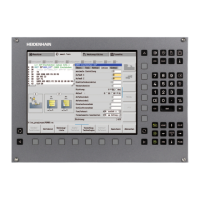January 2012 6.16 The Control Loop 829
The jerk defined in MP_maxPathJerk is effective for machining feed rates in
all channels that do not exceed the maximum machining feed rate from
MP_maxG1Feed. MP_maxPathJerk has a higher priority than
MP_axPathJerk (CfgLaAxis). This means that MP_maxPathJerk limits the
vector sum of axis-specific path jerks.
MP_maxPathJerk
Maximum jerk on the path
Available from NCK software version: 597 110-01.
Format: Numerical value
Input: 0.000 to 1 000 000.000 [m/s3]
Default: 40 [m/s3]
Access: LEVEL3
Reaction: RUN
The jerk defined in MP_maxPathJerkHi is effective for feed rates greater than
the feed rate defined in MP_maxG1Feed. MP_maxPathJerkHi has a higher
priority than MP_axPathJerkHi (CfgLaAxis). This means that
MP_maxPathJerkHi limits the vector sum of the axis-specific path jerks at
rapid traverse.
MP_maxPathJerkHi
Maximum jerk on the path at rapid traverse
Available from NCK software version: 597 110-01.
Format: Numerical value
Input: 0.000 to 1 000 000.000 [m/s3]
Default: 40 [m/s3]
Access: LEVEL3
Reaction: RUN
Independent of the feed rate, define the maximum yank (dj/dt) in
MP_maxPathYank.
The maximum yank normally does not have to be limited in the path direction
with MP_maxPathYank (= change of the jerk per time). Therefore, you can
usually set the parameter to its maximum value.
Under unfavorable conditions, very short jerk phases (in the range of the first
natural frequency of the axis) may lead to oscillations in the workpiece. By
reducing MP_maxPathYank, you can prolong the jerk phases to a certain
extent and thus reduce the oscillations in the workpiece.

